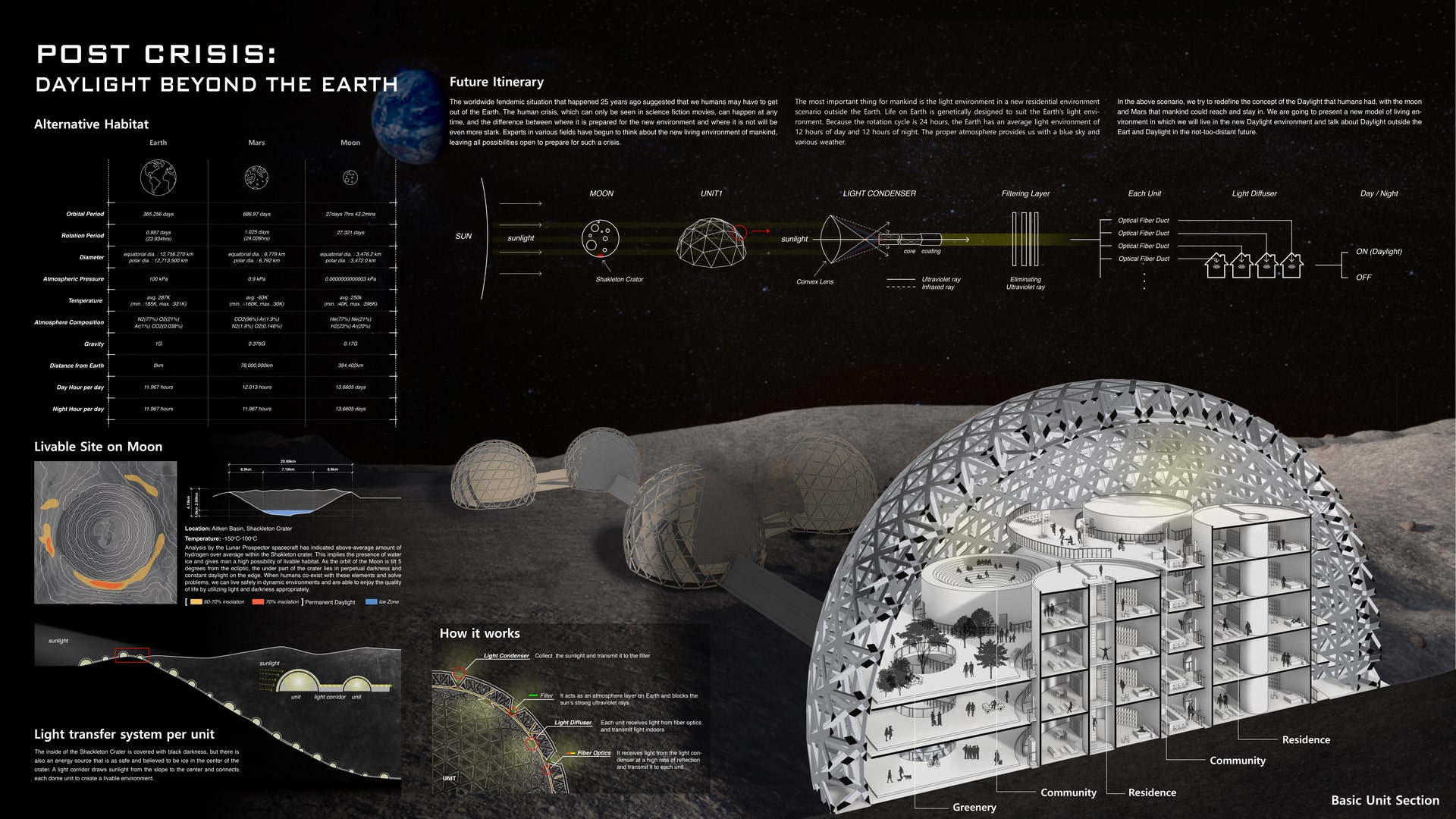Project Description
In the near future humanity will face a new era. The global pandemic we are experiencing currently indicates that as well. The consequence that well-prepared countries will face will be vastly different from the under prepared countries. Along with the crises we are facing today, more crises can emerge anytime and anywhere in the near future. For instance, a new epidemic or a virus could emerge, polluting the entire Earth's atmosphere and those scenarios are no longer just science fiction. Therefore, searching for a habitat outside of the Earth is becoming inevitable. By leaving all possibilities open and preparing, we can then respond to the imminent crisis. If there is a slight chance of overcoming the global pandemic, we have to examine thoroughly. One solution to the preparation of the future crisis would be the suggestion of a new habitat. Our team defines ‘new’ as a means of a place outside the earth where humans can be aware of the flawless environment. As global technology is getting advanced especially in architecture and space technologies, living beyond our territory is a high probability. Before careful consideration of the site, what our team took into consideration the most is daylight; an essential element for humans to survive. Life on Earth was designed from the beginning to suit the Earth's daylight. The unique light environment of the Earth by a cycle of 24hours provides dazzling daylight to people. We seek diverse actions to convey this advantage to the place outside the Earth. Where would be most habitable outside of Earth? Mars and the moon have long been candidates for human habitation. Mars has a similar daylight cycle to Earth with its 686.97-day orbital period and 1.025-day rotation period. On the other hand, the moon has a subtle difference of 27.743-day orbital period and 27.432-day in rotation period. In addition, the distance to Mars is much greater than the distance to the moon. Earth is 203 times closer to the moon than Mars. Moreover, the moon is the only place besides Earth where humans have ever stepped foot. As a result, our team chose the moon as an alternate habitat. However, the concept of "daylight," on the moon changes from the very beginning. Daylight on the moon lasts 15 days. It is completely different from the life cycle that we have had before. Therefore, we had to take proper action. Developing ideas We decided to design with a main focus on light. Normally, the buildings would have to store the light and collect light energy for 15 nights at most of the craters. While analyzing feasibility, we found a crater called Shackleton which has constant daylight at the edges and permanent darkness inside. The pole of this crater is superior in all conditions except the darkness. The protection of external convulsion conditions is guaranteed at the base of the bowl shape. As designing the building under an identical condition is ideal, we only had to consider the flow of the light so that it can spread equally inside the buildings. To spread an equal amount of light, we adopted a dome shape with bridge connections. Just like the heart in a human body, the light corridor supplies daylight throughout the site. And it serves as an atmosphere protecting the surface from ultraviolet rays while providing natural daylight at the same time. Between the light corridors, the building where people live is a dome shape. The dome, especially geodesic, provides a vast space without heavy columns and it is an efficient form due to its low gravity. For these purposes, each building and bridge were adopted with this basic strategy. Three column shape towers work as a function of a core and housing. Each tower is organized with 64 square meters for minimum residential space. The rest of the towers work as community programs. Spaces between towers have amenities such as front yards, playgrounds, parks, and farms. The structure of each dome is constructed with its unique material which consists of light condensers to collect natural sunlight. Under the condensers, filters and fiber optics block ultraviolet rays and provide usable light to the dome units. Light diffuser finally transmits natural daylight inside the dome. Only those who are prepared can face the unexpected future. Innovative thoughts and dealing with fundamental challenges, such as expanding daylight definition, are essential to developing insight. We believe that imagining the future and suggesting innovative solutions are the crucial steps to achieving an architectural revolution in daylight.
